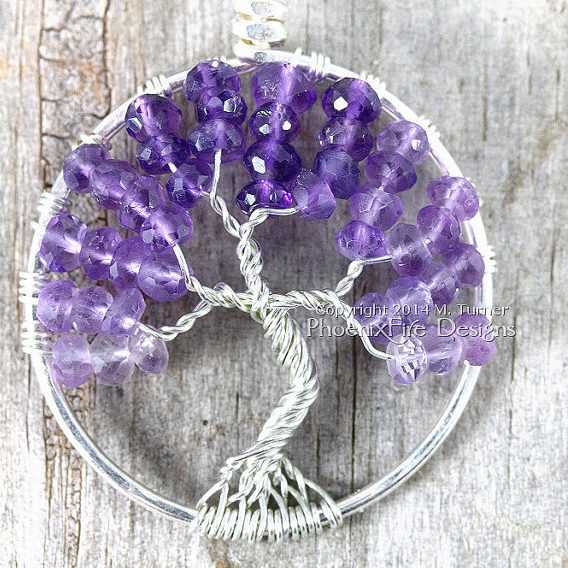For individuals with February birthdays, the amethyst makes a perfect birthstone. This month is often cold, dark, and short for many people around the world, so the amethyst—which is often associated with qualities of peace, courage, and stability—is the right gem for individuals who need a little extra warmth and strength this time of year.
Beautiful purple quartz, the amethyst is an easily recognizable gem, but you may not know everything about it just yet! Take a look below to learn more about the amethyst.

AMETHYST
 |
| Yael Designs |
Amethyst is purple quartz and is a beautiful blend of violet and red that can be found in every corner of the earth. The name comes from the Ancient Greek, derived from the word “methustos,” which means “intoxicated.” Ancient wearers believed the gemstone could protect them from drunkenness.
Amethyst, as previously mentioned, is composed of quartz, which is the second most abundant material found in the Earth’s crust. Amethyst gets its color from irradiation, iron impurities, and the presence of trace elements. Its hardness (a 7 on the Mohs scale) is the same as other quartz, which makes it a durable and lasting option for jewelry.
While amethyst is most commonly recognized to be a purple color, the gemstone can actually range from light pinkish violet to a deep purple that can read more blue or red, depending on the light. Sometimes, even the same stone can have layers or color variants, so the way the gemstone is cut is important to the way the color shows in a finished piece.
Amethyst often occurs in geodes or in the cavities of granitic rocks. It can be found all over the world, including the United States, Canada Brazil, and Zambia.
The amethyst is not only the February birthstone, but it is also used to celebrate the 6th and 17th year of marriage.
 |
| Supreme Jewelry |
Amethyst, the gemstone believed by ancient Greeks and Romans to ward off the intoxicating powers of Bacchus, also was said to keep the wearer clear-headed and quick-witted. Throughout history, the gemstone has been associated with many myths, legends, religions, and numerous cultures. English regalia were even decorated with amethysts during the Middle Ages to symbolize royalty. Amethyst jewelry has been found and dated as early as 2000 BC.
Some historical accounts say that Saint Valentine had an amethyst ring carved with an image of Cupid. And for those familiar with Old Testament history, amethyst was one of the twelve gemstones that represented the twelve tribes of Israel.
For many years, amethyst was held to be one of the most precious gemstones, often favored by royalty or exclusively by the clergy as a symbol for the deity of Christ. It was even held for many years in the same regard as the diamond. It wasn’t until the discovery of more abundant supplies of amethyst that it became a gemstone enjoyed by more than just the wealthiest buyers.
Many wearers of amethyst throughout history and even today prize the gem for its symbolism as well as its beauty. Leonard da Vinci once said that amethyst helps to quicken intelligence and get rid of evil thoughts. Other qualities like peace, stability, courage, and strength are said to be derived from this gemstone.
Today, many wearers simply prize the amethyst for its beautiful shade and the way it complements both warm and cool colors.
 |
| Parlé Gems |
Whether you’re purchasing an amethyst for yourself or a loved one, you’re making an investment in a beauty that will stand the test of time. Amethyst makes a great gift for individuals born in February, or as a celebratory milestone for a 6th or 17th wedding anniversary.
Of course, you’re also welcome to purchase amethyst “just because.” It’s a beautiful gemstone that ranges in color from light pinkish violet to a deep red or blue-purple violet and complements a number of metals and settings. It’s a durable gemstone that works well with warm or cool colors, so it’s safe to say it goes well beyond special occasion jewelry and can be worn every day, as well.
When looking to purchase amethyst, first visit an AGS jeweler, who is trained and certified to ensure that the consumer has the best information to make a great purchase.
Next, check the color of the stone. Amethyst often has “stripes” or layers of color from how and when it was formed, so it takes a skilled gemologist to cut and polish the stone to show the overall color of the stone evenly. Avoid brownish or rust-colored tints to the stone and be careful the color is not too deep or it can appear black in some lights.
Like diamonds, you can also look for clarity in an amethyst. Most gemologists will favor a richly colored stone with some minor inclusions (not eye-visible), since the color of this gem is so highly prized. In lighter-colored amethysts, visible inclusions will greatly reduce the value of the gemstone.
Since amethyst is relatively plentiful, the price differential in carat sizes isn’t usually terribly significant, so this can be a great gemstone for statement jewelry pieces (though you may not be able to cost-effectively recreate some of Elizabeth Taylor’s memorable amethyst jewelry or the “Kent Amethysts” owned by the British crown).
Larger rings, earrings, or pendants can make a stunning addition to a jewelry collection, but even smaller amethysts can be deeply and richly colored, making subtler pieces beautiful, too.
Source: https://www.americangemsociety.org/page/februarybirthstone


